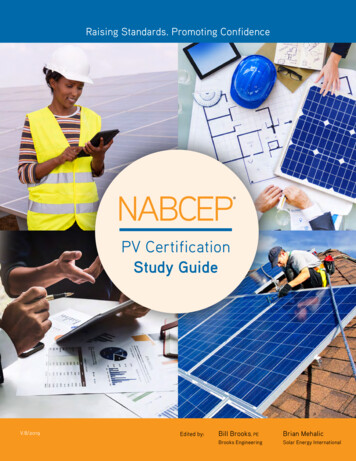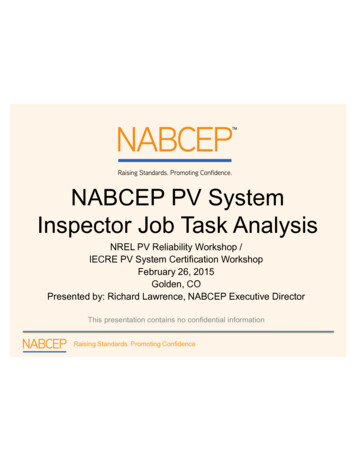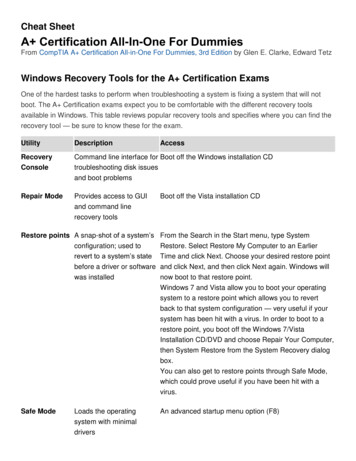
Transcription
Raising Standards. Promoting ConfidencePV CertificationStudy GuideV.8/2019Edited by:Bill Brooks, PEBrian MehalicBrooks EngineeringSolar Energy International
SolarRoofHookis nowIn 2011, we sought out to invent a mounting system that sealspenetrations on Asphalt Roofs without lifting Shingles. We receiveda patent and now, 7 years later, the product has finally gainedacceptance as the world’s 1ST UL Certified Microflashing and aground-breaking way to mount solar on top of asphalt.That product name is: QuickBOLT.The new name of our Solar Division is: QuickBOLT.NOLIFTINGSHINGLESNOREMOVINGNAILSINSTALL INLESS THAN30 SECONDSwww.quickbolt.com(844) 671-6045 MON-FRI: 7AM-5PM PST
Welcome to the 2019 edition of the NABCEP Board Certified PVCertification Study Guide. This Study Guide is intended to be a useful studyguide for individuals studying to take a NABCEP Board Certification exam inPV, a supplemental textbook for training courses, and a general reference book forpractitioners in the field.This edition follows the most recent version of the NABCEP PV InstallationProfessional Job Task Analysis (JTA) as well as the JTAs of the NABCEP PV DesignSpecialist, PV Installer Specialist, and PV Commissioning & Maintenance SpecialistBoard Certifications, which can be found at www.nabcep.org. The JTAs definethe jobs of PV professionals who specialize in the design, installation, operations,commissioning, and maintenance of PV systems. NABCEP’s JTAs are the foundationfor its Board Certification examinations, and each JTA breaks down the percentageof exam questions that come from each domain. Candidates preparing for one ofNABCEP’s Board Certification exams should first review the relevant Job Task Analysisto see what areas in the body of knowledge are required to pass the exam, and do anhonest and thorough self-evaluation to determine what areas they may need to study.This guide is one of the “primary references” utilized by the ExaminationCommittees in creating test questions for the NABCEP PV Installation Professionaland PV Specialist Board Certification exams; however, it should not be consideredthe sole resource to use in preparing to take an exam. Questions on the exam aredeveloped using the material in all of the primary resources, particularly the NationalFire Protection Agency’s National Electrical Code. A list of primary resources maybe found on nabcep.org. While this guide contains a lot of useful information,compiled by two of the most respected authors in the solar installation industry,it is not intended to be the definitive word on PV design, installation, operation,commissioning, or maintenance.Table of Contents1. Introduction . . . . . . . . . . . . . . . . . . . . . . . . . . . . . . . . . . . . . . . . . . 62. System Design . . . . . . . . . . . . . . . . . . . . . . . . . . . . . . . . . . . . . . . . . 93. Installation . . . . . . . . . . . . . . . . . . . . . . . . . . . . . . . . . . . . . . . . . . . 814. System Commissioning . . . . . . . . . . . . . . . . . . . . . . . . . . . . . . . . 1105. Operations & Maintenance . . . . . . . . . . . . . . . . . . . . . . . . . . . . . 123AppendixesExam References . . . . . . . . . . . . . . . . . . . . . . . . . . . . . . . . . . . . . . . . 124Case Study Examples . . . . . . . . . . . . . . . . . . . . . . . . . . . . . . . . . . . . . 136
Thank you to our Study Guide SponsorsRESPECT THE ROOF
Acknowledgements:NABCEP wishes to thank thecompanies and individuals who havemade this Study Guide possible.This document is the result of theefforts of its principal authors: BillBrooks (Brooks Engineering) andJim Dunlop (Jim Dunlop Solar).It is also the result of review andcontributions made by membersof the NABCEP PV CertificationStudy Guide Committee. We aregrateful to the following individualsfor their contributions (companynames provided are from wherethe individual worked immediatelybefore the date of this Study Guide’spublication, and may not be thelocation of current employment):PRINCIPAL AUTHORSBill Brooks, PEBrooks EngineeringJim DunlopJim Dunlop SolarForward/ScopeThis document was developed toprovide an overview of some of the basic requirementsfor solar photovoltaic (PV) system installations and thosewho design, install, and maintain them. The guide isorganized according to the NABCEP PV InstallationProfessional Job Task Analysis (PVIP JTA), an industrydeveloped and validated outline of the tasks involved inthe design, installation, and maintenance of PV systems.Readers should use the PVIP JTA and this guide alongwith the 2017 National Electrical Code (NEC ), thegoverning building codes and other applicable codes andstandards. These codes and standards are referenced oftenthroughout this document, and are the principal rulesthat govern the installation of PV systems and any otherelectrical equipment. A thorough understanding of theserequirements is essential for PV system designers andinstallers.Non Endorsement Statement: The North American Board of CertifiedEnergy Practitioners (NABCEP) does not assume any legal liability orresponsibility for the products and services listed or linked to in NABCEPpublications and website. Reference to any specific commercial product,process, or service by trade name, trademark, manufacturer, or otherwise,does not constitute or imply NABCEP’s endorsement or eniousPVingeniousPV.comLive Solar & NYC Techlivesolar.comIndependent Powerindependentpower.netViridian Energy Co-operativeviridianenergy.caGlobal Sustainable Energy Solutionsgses.com.auVivint Solarvivintsolar.comPlanet Plan Setsplanetplansets.comMastering Greenmastering-green.comMike Holt Enterprisesmikeholt.comC-TEC Solarctecsolar.comBorrego Solar Systemsborregosolar.comSolPowerPeople, Inc.solpowerpeople.comWhite House Solarmaximumpowerpointtraining.comQuick Mount PVquickmountpv.comEnSync Energy Systemsensync.comThis document is a collaborative effort, and is considereda work in progress. Future editions of this guide willincorporate comments, corrections and new content asappropriate to reflect new types of products, installationmethods or code requirements.Units of MeasureBoth the International System of Units (SI) and theU.S./Imperial customary units of measure are usedthroughout this document. While SI units are generallyused for solar radiation and electrical parameters, U.S./Imperial customary units are used most commonly in theU.S. construction industry for weights or measure. PVprofessionals are expected to be comfortable with usingboth systems of measurement and converting betweenthe two given the appropriate unit conversion factors.NABCEP56 Clifton Country RoadSuite 202Clifton Park, NY 12065800-654-0021 / info@nabcep.orgwww.nabcep.org
INTRODUCTIONThis Photovoltaic (PV) Certification Study Guide is an informational resource intendedfor individuals pursuing a Board Certification in the field of photovoltaics from the NorthAmerican Board of Certified Energy Practitioners (NABCEP).This guide covers some of the basic requirements for the design, installation, operations,commissioning, and maintenance of PV systems. Individuals should use this guide inconjunction with other resources in preparation for NABCEP’s Board Certification examsrelated to PV.To qualify for an exam, candidates should first carefully read the NABCEP CertificationHandbook, which outlines specific prerequisites for education, training, and professionalexperience in a decision-making role, to qualify for the Board Certification exam. Forfurther information on NABCEP’s Board Certification programs, and how to apply,and to download the latest NABCEP Certification Information Handbook, go -2.This guide is organized and closely associated with the NABCEP PV Installation ProfessionalJob Task Analysis (JTA), but it is written to also relate to the JTAs for the NABCEP PVDesign Specialist, PV Installer Specialist, and PV Commissioning & Maintenance SpecialistBoard Certifications. The JTA outlines the normal duties of a qualified PV professional,and defines the general knowledge, skills, andabilities required of those who specify, install,operate, commission, and maintain PV systems.JTA Job DescriptionJTAs form the blueprint for NABCEP Boardfor NABCEP Certified PVCertification examination content and should beInstallation Professionalreferenced often when reviewing this document.The JTAs are available for download from theGiven a potential site for a solar PVNABCEP website, at http://www. nabcep.org/The objectives of this guide are to provide generalinformation, and additional resources concerningthe key areas for working with PV systems. Thisguide is not an all-inclusive or definitive studyguide for the exam, and exam questions are notnecessarily based on the contents of this resourceguide. NABCEP offers practice exams for anyoneinterested in preparing to take one of its exams.Practice exams are available for purchase onour website, at http://www.nabcep.org/nabceppractice-exams.6 Introductionsystem installation, and given basicinstructions, major components,schematics, and drawings, the PVinstallation professional will: specify,adapt, implement, configure, install,inspect, and maintain any type ofphotovoltaic system, including gridconnected and stand-alone systemswith or without battery storage, thatmeet the performance and reliabilityneeds of customers by incorporatingquality craftsmanship and complyingwith all applicable codes, standards,and safety requirements.Copyright 2019 NABCEP v.8NABCEP PV Certification Study Guide
Everything Under the SunFrom quality products and customized configurations,to warrantied connections with reliable tools, BURNDY saves you time andmoney by being your single source for all solar installation needs. BURNDY LLC, 2017www.burndy.comHELP YOUR CUSTOMERS ACHIEVEENERGY PEACE-OF-MIND &ENERGY INDEPENDENCEInverter/ChargersCharge ControllersInterconnection System Equipmentwith Magnum Energy power conversion solutionsfrom Sensata Technologies.www.SensataPower.com2018-PV resource guide ad.indd 111/7/17 4:34 PM
Photovoltaic Systems OverviewThe PV installer must be familiar with a wide range of PV systems that they may encounter.PV systems are electrical power generation systems that produce energy. They vary greatly insize and their applications, and can be designed to meet very small loads from a few watts orless up to large utility-scale power plants producing tens of megawatts or more. PV systemscan be designed to supply power to any type of electrical load at any service voltage.PV System ComponentsThe major component in all PVsystems is an array of PV modulesthat produces dc electricity whenexposed to sunlight. Other majorcomponents may include powerconditioning equipment, energystorage devices, other power sourcesand the electrical loads. Powerconditioning equipment includesinverters, dc-to-dc converters,chargers, charge and load Figure 1. PV system componentscontrollers, and maximum powerpoint trackers. Energy storagedevices used with PV systems are mainly batteries, but may also include advanced technologieslike flywheels or other forms of storing electrical energy or the product, such as storing waterdelivered by a PV water pumping system. Other energy sources coupled with PV systems mayinclude electrical generators, wind turbines, fuel cells and the electric utility grid. See Fig. 1.1251. PV modules and array642. Combiner box3. DC disconnect4. Inverter (charger & controller)5. AC disconnect36. Utility service panel72011 Jim Dunlop Solar7. Battery (optional)Solar Radiation: 2 - 2Balance-of-system (BOS) components include all mechanical or electrical equipment and hardwareused to assemble and integrate the major components in a PV system together. Electrical BOScomponents are used to conduct, distribute and control the flow of power in the system.Examples of BOS components include: Conductors and wiring methods Raceways and conduits Junction and combiner boxes Disconnect switches Fuses and circuit breakers Terminals and connectors Grounding equipment Array mounting and other structural hardware8 IntroductionCopyright 2019 NABCEP v.8NABCEP PV Certification Study Guide
With over 10 years of experience in the US solar distributionmarket, BayWa r.e. Solar Systems understands there aretimes of turbulence and uncertainty in the solar industry.We are committed to providing you with seamless supportthrough the ups and downs, to help you run a successful solarbusiness.As one of the largest suppliers of solar equipment in theworld, we are well-known for our stability as a partner.r.e.think energyWe are here to empower and support you in every area of yoursolar business – from planning to purchasing to installation – youcan count on BayWa r.e. Solar Systems to be the partner youneed.Visit solar-distribution-us.baywa-re.com to learn more.
Figure 2. Stand-alone PV systems operate autonomously and are designed to meet specificelectrical loads.Types of PV systems areclassified based on the loadsthey are designed to operate,and their connections withother electrical systemsand sources. The specificcomponents needed dependon the type of system and itsfunctional and operationalrequirements.PV ArrayChargeControllerDC LoadBatteryInverter/ChargerAC LoadAC Source(to Charger Only) 2011 Jim DunlopSolarSystemComponents and Configurations:4-2Figure2. Stand-alonePV systems operateautonomouslyand aredesigned to meet specific electrical loads.Stand-alone PV systemsoperate independently ofother electrical systems, and are commonly used for remote power or backup applications,including lighting, water pumping, transportation safety devices, communications, off-gridhomes and many others. Stand-alone systems may be designed to power dc and/or acelectrical loads, and with a few exceptions, connect with energy storage systems. A standalone system may use a PV array as the only power source, or may additionally use windturbines, an engine-generator, or another auxiliary source.Interactive PV systems operate in parallel and are interconnected and synchronized withthe electric utility grid. When connected to local distribution systems, interactive systemssupplement utility-supplied energy to a building or facility. The ac power produced byinteractive systems either supplies on-site electrical loads or is back-fed to the grid when thePV system output is greater than the site load demand. At night, during cloudy weatheror any other periods when the electrical loads are greater than the PV system output, theadditional power required is received from the electric utility. Interactive PV systems arerequired to disconnect from the grid during utility outages or disturbances for safety reasons.Self-consumption interactive systemswork with energy storage systemsAC Loadsthat can feed the building loadsfrom the PV system or the battery atdifferent times of the day. This allowsLoadthe PV and energy storage to shiftPV ArrayInverterCenterproduction to different times whenit is most beneficial to the utility bill.ElectricOnly special battery-based interactiveUtilityinverters can provide stand-alonepower for critical loads independent Figure 3. Utility-interactive PV systems operate in parallel withfrom the grid during outages. Seethe electric utility grid and supplement site electrical loads.Fig. 3.Figure 3. Utility-interactive PV systems operate in parallel with the electric utility grid andsupplement site electrical loads.2011 Jim Dunlop Solar10 IntroductionSystem Components and Configurations: 4 - 3Copyright 2019 NABCEP v.8NABCEP PV Certification Study Guide
SYSTEM DESIGN1. Designing the PV System andManaging the ProjectA NABCEP Certified Professional is often an installer, a project manager, an installationforeman/supervisor, or a system designer. They must know how to interpret, review,and generate system designs. They must also be able to evaluate site issues affecting thedesign, identify discrepancies in the design or with code compliance, and recommend andimplement appropriate corrective actions or alternatives. PV installation professionals have athorough understanding of system designs, including their major components, functions andinstallation requirements.NABCEP PV Technical Sales CertificationThe NABCEP PV Technical Sales Certification is a credentialoffered for those specifically engaged in marketing and the customerdevelopment process for PV installations. Further information onthis certification program is available on the NABCEP website:http://www.nabcep.org/ eviewing Customer Expectations Task 1An accurate assessment of the customer’s expectations is the starting point for specifying,designing and installing PV systems. Developing and planning PV projects requires anunderstanding of the customer’s expectations from both financial and energy perspectives.Companies and individuals offering PV installation services must interpret the customer’sdesires, and based on the site conditions, clearly explain the options, their trade-offs and costs.They must also explain the functions, maintenance and operating principles for different typesof PV systems. The solar professional must also estimate their performance relative to thecustomer’s electrical loads for a net-metered system and convey how the system design willwork with changing utility rate schedules and other incentives for producing energy and power.As the solar industry grows, PV systems will become more interactive with smart buildings,smart meters, and energy storage systems to increase the value to the customer.Meeting customer expectations includes addressing all other issues affecting the proposedinstallation, such as applicable incentives, changing markets, legal matters, location ofequipment, fast emerging technologies, appearance, understanding codes, standards,covenants and regulations. Code changes happen on an ongoing basis and impact designsand costs of the system. Fundamentally, knowledge of the client’s needs and desires becomethe basis for preparing proposals, quotations, and construction contracts.There are several public domain and many commercial software resources available in thePV industry that address different aspects of project development and systems design. TheNABCEP PV Certification Study GuideCopyright 2019 NABCEP v.8System Design 11
capabilities of these tools range from simple solar resource and energy production estimates,to site survey and system design tools, to complex financial analysis software. Some tools alsoprovide assistance with rebate programs applications and tax incentives, while other programsand worksheets focus on the technical aspects of system sizing and design. Proprietarysoftware is often used by larger solar companies and by solar financing institutions.The following lists some of the popular software tools used in the PV industry:Public Domain (NREL/DOE) PVWATTS: http://pvwatts.nrel.gov/In My Back Yard (IMBY): www.nrel.gov/eis/imby/RET ScreenSystem Advisor Model (SAM): www.nrel.gov/analysis/sam/Google Earth: https://www.google.com/earth/Manufacturers and Integrators Inverter string sizing and various system sizing and design toolsCommercial Clean Power Estimator: www.cleanpower.comPVSYST: www.pvsyst.comOnGrid: www.ongrid.netPVSol: www.solardesign.co.uk/PV F-Chart: www.fchart.comMaui Solar Software: www.mauisolarsoftware.com/HOMER: www.homerenergy.com/Helioscope: https://helioscope.folsomlabs.com/AuroraSolar: http://www.aurorasolar.com/Energy PeriscopeAssessing Energy UseKnowledge of the customer’s electrical loads and energy use are important considerations formany types of PV installations. The energy produced by PV systems will often offset energyderived from another source and represents a return on the customer’s financial investment.For net-metered, stand-alone and self-consumption systems, be prepared to evaluate anddiscuss the customer’s energy use relative to the PV system options and their expectedperformance. This can be as simple as reviewing electrical bills for the past year or longerif available. See Fig 5. For new construction or off-grid applications, the energy use can beestimated from equipment ratings and expected load use profiles, but estimates can be highly12 System DesignCopyright 2019 NABCEP v.8NABCEP PV Certification Study Guide
DSIREFigure 4. The Database of StateIncentives for Renewable Energy (DSIRE)contains information on rules, regulationsand policies for renewable energy andenergy efficiency programs in all states.Many websites provide information concerninglocal and state regulations for PV installations,including incentive programs, utility interconnectionrules, and requirements for contractor licensing,permitting and inspection. The Database of StateIncentives for Renewable Energy (DSIRE) is anexcellent source for this information, and includesup-to-date summary information and numerous linksto federal, state and local websites. For additionaldetails, see: www.dsireusa.orginaccurate. Actual measurements are always preferred, and there are a number of low-costelectronic watt-hour meters available that can be readily installed to measure specific loads,branch circuits or entire electrical services. Load information is used to size and design PVsystems, estimate their performance and to conduct financial evaluations.For stand-alone PV applications, load energy consumption dictates the size and cost of theasessments are a must. In many PV syPV system required, and is a critical design parameter.For these systems, accurate load assessments are a must. In many cases, a customer couldhave a greater benefit in changing equipment or practices to minimize their energy use,rather than installing a larger PV system to offset inefficient loads or habits.Interactive (grid-connected) PV systems may be designed to satisfy a portion of existing siteelectrical loads, but generally no more than the total energy requirements on a net basis.Systems using energy storage (batteries) for off-grid and utility back-up applications requirea detailed load analysis to adequately size the array, battery, and inverter for stand-aloneoperation. Many PV system sizing worksheets and software tools incorporate means to inputa given electrical load and estimate the PV to load energy contribution in the results.Figure 5. Electric bills are reviewed as part ofa site survey to evaluate customer energy use.NABCEP PV Certification Study GuideElectrical loads are any type of device, equipment orappliance that consumes electrical power. Electricalloads are characterized by their voltage, powerconsumption and use profile. Many types of electricalloads and appliances are available in high-efficiencymodels. Alternating-current (ac) loads are poweredby inverters, generators or the utility grid. Directcurrent (dc) loads operate from a dc source, such as abattery. Some small off-grid PV system applicationsuse only dc loads, and avoid having to use an inverterto power ac loads.Copyright 2019 NABCEP v.8System Design 13
Power and Energy BasicsAn understanding of power and energy fundamentals is essential for the PV professional.Electrical power is expressed in units of watts (W):1 megawatt (MW) 1,000 kilowatts (kW) 1,000,000 watts (W)Electrical energy is expressed in units of watt-hours (Wh):1 kilowatt-hour (kWh) 1000 WhPower and energy are related by time. Power is the rate of transferring work or energy, andanalogous to an hourly wage ( /hr) or the speed of a vehicle (mi/hr). Energy is the total amountof work performed over time, and analogous to total income earned ( ) or distance traveled (mi).Simply stated, energy is equal to the average power multiplied by time:Energy (Wh) Avg. Power (W) time (hr)1.2 Assess Project Site Task 3Site surveys are used to collect information about the local conditions and issues affectinga proposed PV installation. This information is documented through records, notes,photographs, measurements and other observations and is the starting point for a PV project.Ultimately, information from site surveys is used in combination with the customer desires asthe basis for preparing final quotations, system designs, and planning the overall installation.There are many aspects to conducting a thorough site survey. The level of detail depends onthe size and scope of the project, the type of PV system to be installed, and where and howit will be installed. Greater considerations are usually associated with commercial projects,due to the larger equipment and increased safety hazards involved. Obtaining the necessaryinformation during a site survey helps plan and execute PV installations in a timely andcost-effective manner. It also begins the process of assembling the system manuals and projectdocumentation.A number of tools, measuring devices, special equipment and safety gear may be required forconducting site surveys. See Fig. 6. Some of the basic equipment includes: Appropriate PPE including hardhats, safety glasses, safety shoes, gloves and fallprotection equipment Basic hand tools, ladders, flashlights, mirrors and magnifying glasses Tape measures, compasses, levels, protractors and solar shading calculators Voltmeters, ammeters, watt and watt-hour meters, and power quality analyzers Graph paper, calculator, audio recorders, cameras and electronic notebooks14 System DesignCopyright 2019 NABCEP v.8NABCEP PV Certification Study Guide
Figure 6. A variety of tools and equipment may be required for a site survey. 2011Jim6.DunlopSolarSystem Components and Configurations: 4 - 6FigureA varietyof tools and equipment may be required for a site survey.A PV installer must evaluate whether a proposed site will be suitable for the installation andproper operation of the system. In general, a site assessment involves determining: A suitable location for the array Whether the array can operate without being shaded during critical times The mounting method for the array Where the balance-of-system (BOS) components will be located How the PV system will be interfaced with existing electrical systems1.2.1 Array LocationPV arrays can be mounted on the ground, rooftops or any other suitable support structure.The primary considerations for optimal PV array locations include the following: Is there enough surface area available to install the given size PV array? Can the array be oriented to maximize the solar energy received? Is the area minimally shaded, especially during the middle of the day? Is the structure strong enough to support the array and installers? How will the array be mounted and secured? How far will the array be from other system equipment? How will the array be installed and maintained? Will the array be subjected to damage or accessible to unqualified persons? Are there local fire codes or wind load concerns that limit rooftop areas forPV installations? Are there additional safety, installation or maintenance concerns?The answers to these and other questions will help determine the best possible locationsfor installing PV arrays. There are many trade-offs, and designers and installers need toevaluate potential locations based on the site conditions and other available information, anddetermine if a PV installation is feasible.NABCEP PV Certification Study GuideCopyright 2019 NABCEP v.8System Design 15
Array AreaIndividual PV module characteristics and their layout dictate the overall surface area requiredfor a PV array with a specified peak power output rating. The surface area required for agiven array depends on many factors, including the individual module dimensions, theirspacing in the array, and the power conversion efficiency of the modules used. Fire safetycodes, wind loads and accessibility to the array for installation and maintenance must alsobe considered when evaluating suitable array locations and layouts, and may limit possiblelocations to install PV arrays. PV arrays installed in multiple rows of tilted racks or ontrackers require additional spacing between each array mounting structure to prevent row torow shading.Power densities for PV arrays can vary between 6 and 20 watts per square foot (W/sf ) andhigher, depending on module efficiency and array layout. For example, the power density ofa 260 watt crystalline silicon PV module with a surface area of 17.3 sf is calculated by:260/17.3 15.0 W/sfFor a 4 kW PV array, the total module surface area required would be:4000 W 15 267 sfThis is approximately the area of 10 sheetsplywood.Additionalareais foot,usuallyrequiredFigure of7. Fora power densityof 10 watts persquarea 500 kWPV array can be installed in a50,000 square foot area.for the overall PV array installation and other equipment. Given the required spacingfor commercial rooftopinstallation, it usuallytakes about 80 to 100sf of surface area for a 1kWdc rated PV array usingstandard crystalline siliconTotal roof area:100,000 sq. ft.PV modules. For example,370 ftassuming an array powerdensity of 10 W/sf, a 1 MWPV array would require100,000 sf of array area,270 ftslightly larger than two acresand the approximate size ofFigure 7. For a power density of 10 watts per square foot, a 500the rooftops on big box retailkW PV array can be installed in a 50,000 square foot area.establishments. See Fig. 20117. Jim Dunlop SolarSystem Components and Configurations: 4 - 7Sun Position and the Solar WindowThe location of the sun relative to any point on earth is defined by two ever-changing angles.The solar azimuth angle defines the direction of the sun’s horizontal projection relative to apoint on earth, usually symbolized by the Greek letter Psi (c). For example, with compassheadings, north is 0 or 360 , east is 90 , south is 180 and west is 270 . However, some solarequipment and comput
for solar photovoltaic (PV) system installations and those who design, install, and maintain them. The guide is organized according to the NABCEP PV Installation Professional Job Task Analysis (PVIP JTA), an industry developed and validated outline of the tasks involved in the desi










